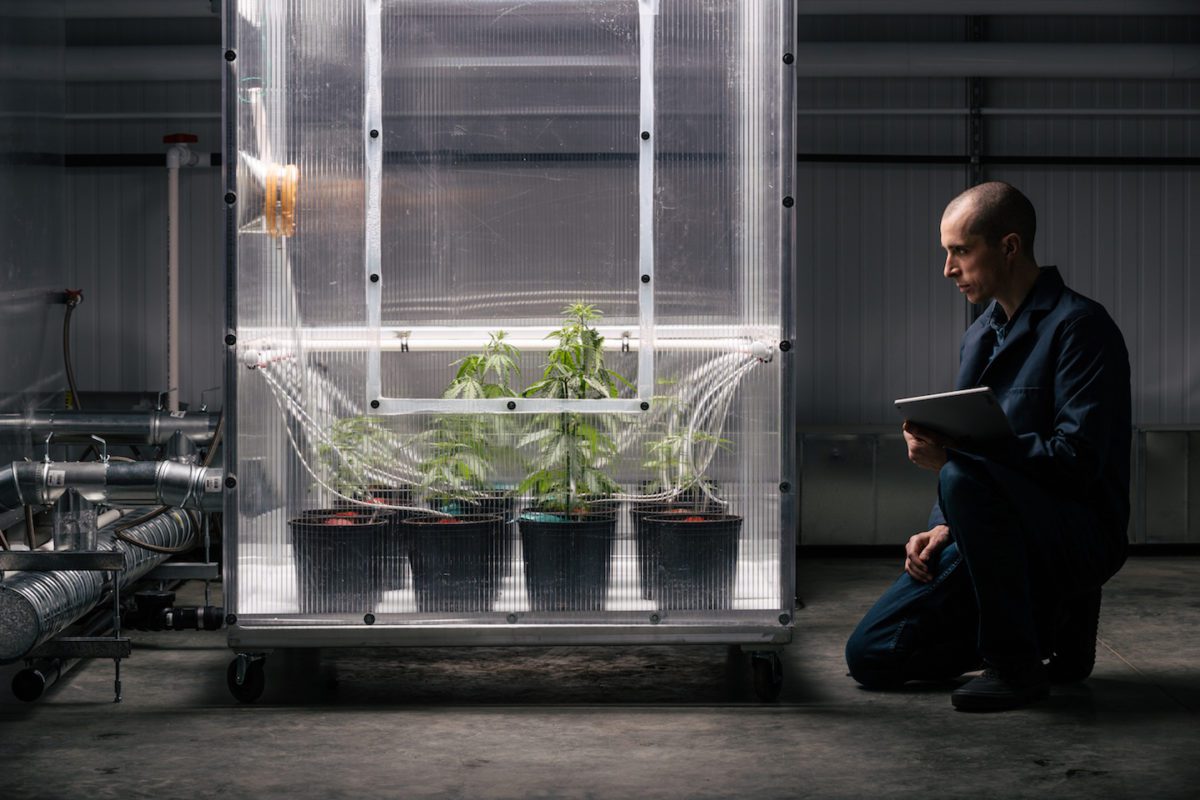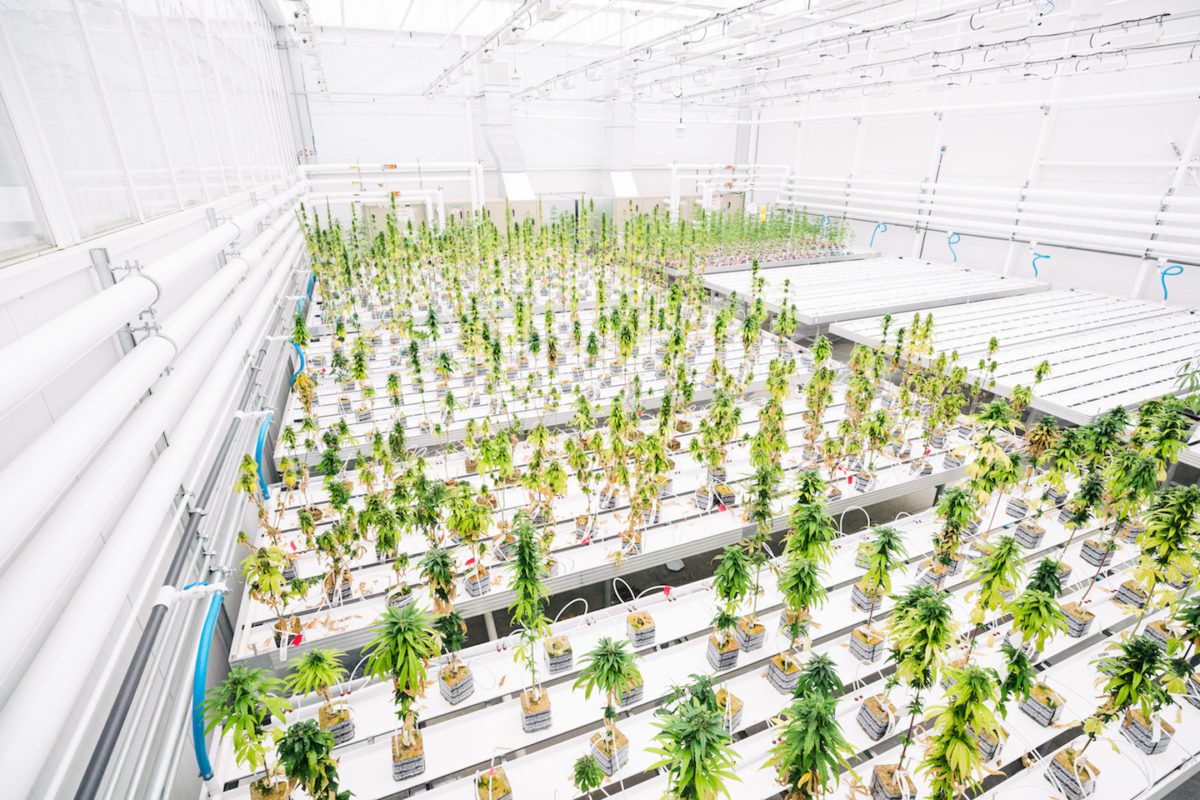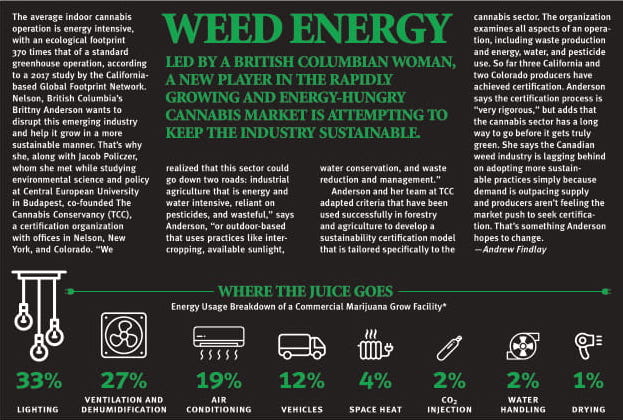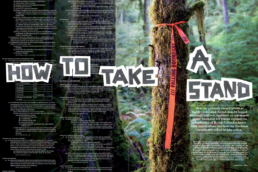Since legalization in 2018, Canada’s cannabis industry has predictably grown at a healthy rate. As the number of companies surge, one man leads a marijuana business mega-player,establishing a next-level, world-class research facility in Comox, British Columbia. But what exactly are Dr. Jonathan Page and his merry band up to behind walls built on the promise of weed? By Andrew Findlay. Photos by Haruki Noguchi.
On a sunny fall afternoon, Dr. Jonathan Page strolls through a sprawling greenhouse at the Cannabis Innovation Centre (CIC), an impressive operation occupying a large industrial site near the Comox Airport on British Columbia’s Vancouver Island. The centre is owned by Aurora Cannabis Inc., a publicly traded Ontario firm that had an annual revenue of $250 million in 2019, and it’s a decidedly unique enterprise. When the lights first flicked on in early 2020, staff filled the state-of-the-art greenhouse with thousands of cannabis plants in pursuit of science and seeds. It’s a dream project for Page, who is the chief scientific officer at Aurora Cannabis and one of the world’s leading cannabis researchers.

To understand what he’s doing here, it’s important to know that in 2009 he headed up a year-long effort to become the first to sequence the genome of cannabis, a long and winding road map of DNA that contains some 30,000 different genes. Those were strange times. It was legal to study cannabis but illegal to procure bud for the purposes of study. You had to be creative to dive into cannabis genomics, Page says. Although the intricacies of mapping the gene architecture of a pot plant might induce most potheads to yawn and reach for the bong, for a research scientist like Page it was like penning Beethoven’s Fifth. And it would also become an academic calling card for Page, giving him global credibility when it comes to understanding the inner genetic workings of cannabis. In 2018, along with three other researchers, he released the first and much-anticipated cannabis genome map. “The genome project is foundational to everything we’ll be doing here,” he says. “We’re basically going to be producing seeds and data.” Both are intended to yield growth in a rapidly expanding industry.
Cannabis is one of humankind’s oldest domesticated plant species, branching out across the world from the cradle of its early cultivation in central Asia. Six thousand years ago, Chinese farmers grew hemp for fibre. Archeologists uncovered evidence of medicinal and shamanistic cannabis use in both a 2,700-year-old tomb in northern China and a Judean crypt dating back more than 1,700 years. Fast-forward to modern times and cannabis and its derivative hash are the most widely consumed drugs globally. Cannabis gets you high, and its non-psychoactive relative hemp makes a badass fibre. That we know for sure. Beyond that, we know surprisingly little about the plant that humans have had such a long and fascinating association with. Page has made it his life’s mission to unlock the secrets of this mysterious flora that now spans the globe, from backyard Vancouver Island greenhouses to the Himalayan foothills, where forests of it grow wild.

Under Page’s leadership, Aurora is betting heavily on research. The CIC cost $28 million to build. A Dutch company designed and constructed the greenhouse, complete with an autonomous roof-cleaning system and featuring special Danish-designed stainless-steel tables for growing plants. The company could have trimmed costs on the public reception area and research labs, but it chose not to. Contained within a striking timber-framed structure, that portion of the facility was designed by Vancouver’s Local Practice Architecture + Design and constructed from German pre-fabricated cross-laminated timbers, which were coordinated, supplied, and installed by Nelson, British Columbia’s Spearhead Inc. Aurora clearly intends to make an impression on visitors and employees. An indoor bike-storage room and showers are located next to change rooms where staff will don sterile white head-to-toe coveralls before entering the labs. But the question remains: what the hell are they up to in there beyond getting humanity higher?
Up until recently, most plant breeding has been focused on getting people more stoned, and much faster, which means breeding plants with buds containing greater concentrations of tetrahydrocannabinol, or THC. Under Page’s guidance, the CIC will be further unpacking the architecture of cannabis and breeding for characteristics that make the plant more resistant to powdery mildew and fungal pathogens, which are often the bane of cannabis growers. They will also be producing seed stock so the company won’t have to rely on unreliable cloning techniques for cannabis cultivation in its production greenhouses. Aurora needs this investment to pay off. The bubble has officially burst on Canada’s legalized cannabis sector, which has been in free fall as of late. In early February 2020, the company canned its CEO, Terry Booth, and cut 500 jobs, having watched its share price tank from roughly $9 to $2 over the previous six months. According to Page, the CIC hasn’t yet been impacted by the cuts. Despite the glut of legal pot on the market that has its parent company stumbling, the research centre is generating buzz in the nerdy cannabis and plant-science space.

One of its biggest fans is scientist Dan Ovadya. As a young university graduate, the Davis, California-based Ovadya was behind the 1980 biotech start-up Calgene. His company brought the world the genetically modified Flavr Savr tomato before being bought by Monsanto in 1997. Today, he works as the global crop innovations strategy lead at Bayer, the German corporation that bought controversial Monsanto in 2018 for USD$66 billion. Late last summer, Ovadya toured the Comox facility while it was still under construction. He was blown away. “It’s super ambitious. There’s nothing that comes close to this facility in terms of research capability,” he says. “The current state of big cannabis is all about producing the most flower, generating revenue, and hoping new markets open up, and that’s been a tough road recently.” It’s the “green-rush” mentality, capitalizing on the recent legalization of this long-illegal resource. According to Ovadya, most companies, if they’re doing any research at all, are conducting it as an afterthought in a corner of a production greenhouse. Aurora is playing the long game. “Research is expensive, but it’s all about thinking into the future and developing technology or genetics that will solve the biggest issues in the industry, like stable flower composition, maintaining genetics, and helping farmers succeed,” Ovadya says. “Talent is everything in a competitive market, and Jon Page’s leadership in cannabis science speaks for itself.”
How Page, a lab-coat-wearing scientist who enjoys the occasional puff, ended up in a suit and tie with a corner office at one of Canada’s largest cannabis companies is a story of good timing, quick thinking, and smarts. Like a seasoned surfer who knows when to paddle, Page has spent the past half-dozen years riding the wave that is North America’s emerging legal — and corporate — cannabis industry. His intellectual curiosity spawned a good idea that eventually led to its logical conclusion: a business start-up. But it was a long journey. Born in Victoria in 1969, with twin brother, Nick, Jon grew up in the Comox Valley exposed to a laid-back island culture where attitudes to marijuana and other hallucinogens were much more permissive than the prohibitionist mainstream political culture of the day. He was a botanist before he even knew what the word meant. As a kid, he spent hours poking under rotten logs and scouring his parents’ rural property for unusual flora. His interest only grew as he got older. “I was never really a druggie,” he says, “but I was very interested in hallucinogens and plants with medicinal properties and cultural significance.
After high school, Page enrolled at the University of British Columbia (UBC) and earned an undergraduate degree in plant biology. His honours thesis took him to Tanzania to study the use of medicinal plants by our closest relative: chimpanzees. By the time he had completed a PhD back at UBC, he was a widely published academic. Through a Natural Sciences and Engineering Research Council of Canada grant, he travelled to Germany for post-doctoral studies of opium and then cannabis. Page focused on alkaloids, which are organic compounds that have physiological effects on humans. Cannabis contains more than 80 different cannabinoids, a class of fat-soluble alkaloid that includes THC. “At the time, we knew a lot about what is in cannabis, but not a lot about the process of biosynthesis in the plant,” Page says. In 2003, he returned to Canada to head up a lab at the National Research Council’s Plant Biotechnology Institute in Saskatoon, Saskatchewan. A decade of battling the red tape of Stephen Harper’s Conservative government, which was hostile to cannabis research, prompted him to quit and return to UBC as an adjunct professor. Then came the game-changing cannabis genome project at the end of the 2000s, the results of which were published in a 2011 edition of the academic journal Genome Biology. The following year, Page shared a business idea with UBC chemist John Coleman. Anandia Labs was born, with Coleman as chief operating officer and Page as CEO. Two years later, they applied for a grower’s license from Health Canada, an application that wound slowly through government approvals, like a snail on opium. In February 2016, Anandia got the license and the company, based in a warren of bland UBC offices, was well on its way to becoming the go-to lab in the province for the Health Canada-required testing of medicinal cannabis, as licensed producers must have their bud tested for THC, pesticides, pathogens, and other metrics before it hits the market.
 In early 2018, Justin Trudeau’s Liberals were lurching toward fulfilling an election promise to legalize cannabis, eventually passing Bill C-45, the Cannabis Act, into law in June of that year. You could almost hear the high-fives echo across the nation. And at Anandia Labs. That spring, Aurora eyed up the enterprise for a possible acquisition. Meetings were held and numbers scratched out on cocktail napkins were handed back and forth. A deal was struck, and in late spring of 2018, Aurora announced a deal to buy the company for $115 million. Page and Coleman became millionaires overnight. Coleman stayed on to manage Anandia Labs, now an independent arm of Aurora’s global operations and housed in a new building on Great Northern Way in Vancouver. As a testament to Anandia Labs’ meteoric business success, the former business partners keep a descendent of the original purple kush plant whose DNA Page sequenced nearly a decade ago.
In early 2018, Justin Trudeau’s Liberals were lurching toward fulfilling an election promise to legalize cannabis, eventually passing Bill C-45, the Cannabis Act, into law in June of that year. You could almost hear the high-fives echo across the nation. And at Anandia Labs. That spring, Aurora eyed up the enterprise for a possible acquisition. Meetings were held and numbers scratched out on cocktail napkins were handed back and forth. A deal was struck, and in late spring of 2018, Aurora announced a deal to buy the company for $115 million. Page and Coleman became millionaires overnight. Coleman stayed on to manage Anandia Labs, now an independent arm of Aurora’s global operations and housed in a new building on Great Northern Way in Vancouver. As a testament to Anandia Labs’ meteoric business success, the former business partners keep a descendent of the original purple kush plant whose DNA Page sequenced nearly a decade ago.
Page is back where he wants to be, with a lab coat on, at least part of the time, and heading up research for Aurora. He has another reason to be stoked about the road ahead, as he gets to work closely with his brother, Nick. The identical twins meet with me at Land & Sea Brewing Co. in Comox between meetings with their staff of 15 at the CIC. As an accomplished biologist and ecologist himself, Nick ran his own consulting firm, Raincoast Applied Ecology, and spent a few years as the Vancouver Park Board’s biodiversity specialist. He joined Aurora as project coordinator for the Comox facility more than a year ago. “I’ve learned more about water-cooled LED lighting than I ever thought I would,” says Nick, who also applied his extensive stormwater management experience to ensure Aurora met the Town of Comox’s stringent standards. He has become fluent in the various aspects of building a cannabis research facility in a suburban setting, not the least of which is an HVAC system that will scrub the pungent aroma of weed so as not to run afoul of the neighbours.
Jon glances at his phone, which vibrates with messages, and then back up at Nick. There is a synergy between these bright siblings, beyond the obvious physical likeness, as though one can anticipate the thoughts of the other. One senses the whole is greater than the sum of the parts. Jon orders another round of beers as the tasting room fills up with an after-work crowd. “I think some people find it kind of weird working with twins,” Jon admits with a laugh.
Like a seasoned surfer who knows when to paddle, Dr. Jonathan Page has spent the past half-dozen years riding the wave that is North America’s emerging legal — and corporate — cannabis industry
It seems improbable that the first purpose-built modern cannabis research facility in North America, if not the world, landed in Comox. To many people, the once-somnolent seaside community seems home of the white-haired, white-shoed retiree, whose biggest decision of the day is whether to play nine holes or 18. As pleasant as the town’s setting may be, it might have been difficult selling Comox to a young scientist like Greg Baute, the CIC’s head plant breeder, three years ago. Baute was headhunted several years ago from California, where he was working with Dan Ovadya at Monsanto when the controversial biotech giant was mired in lawsuits. In fact, the very thought of it might have induced a protracted yawn. Now there’s a youthful, even hip, buzz to Comox. With two breweries and a tap house opening in the last two years, Comox’s star is on the rise, and the Pages feel it has helped Aurora attract some of the specialized talent, like Baute, who will be putting cannabis under the microscope here.
The mayor of Comox, Russ Arnott, couldn’t be happier to see highly educated millennials studying cannabis science in his town. Comox planners showed uncanny foresight in 2014 when they zoned the property now occupied by Aurora for light industrial development, with cannabis as an acceptable use even though legalization was still four years away. “We didn’t want to see a storage locker business on this site. We wanted a business that would generate some employment. When Aurora approached us, we told them we would be really keen for them to locate here,” Arnott says. “Initially there were some concerns from the public that this was going to be some sort of cannabis retail superstore, but I think most people are pretty excited about it now.”
It seems improbable that the first purpose-built modern cannabis research facility in North America, if not the world, landed in Comox. To many people, the once-somnolent seaside community seems home of the white-haired, white-shoed retiree, whose biggest decision of the day is whether to play nine holes or 18.
It seems improbable that the first purpose-built modern cannabis research facility in North America, if not the world, landed in Comox. To many people, the once-somnolent seaside community seems home of the white-haired, white-shoed retiree, whose biggest decision of the day is whether to play nine holes or 18.
Ovadya says the CIC has caused him to reconsider his perception of Canada as a risk-averse country of cautious citizens, friendly enough but not exactly visionary. Ovadya thinks big picture, as you’d expect of someone who has done time in California’s vibrant tech start-up sector. He sees synergy between the mountains, ocean, and outdoor living of British Columbia’s West Coast and its ability to attract the sort of intellectual talent needed to grow a cannabis technology and business hub, not to mention the potential to capitalize on a wealth of cannabis breeding knowledge accrued over decades of black-market cultivation by pot growers. “I kind of believe Aurora’s Comox facility could transform BC into the cannabis innovation hub for the world,” Ovadya says. Page shares at least part of this enthusiasm, but with clichéd Canadian modesty, he holds his fire on the superlatives. “I’m not saying that we’re the biggest and best,” he says, “but we’ll be doing some very interesting stuff in Comox.” The CIC is his baby, and it’s like coming full circle on a journey that started four decades ago with a curious kid who grew to love plants, especially ones with special properties.
Comox Valley, British Columbia, writer Andrew Findlay has never pitched a story faster or with more passion than when he heard one of Canada’s leading innovators in the marijuana industry was building a cannabis research facility on his home turf.
Andrew Findlay
Andrew Findlay is an award-winning journalist and photographer with a home base on Vancouver Island. Born and raised in British Columbia, he continues to draw inspiration from the people, places, triumphs and travails of the Canadian West, however he ranges across the globe in pursuit of stories. Andrew’s journalistic interests are many; he enjoys peeling back the complex layers of social, environmental and business issues, but is also inspired by travel and outdoor adventure. Magazine and newspaper assignments have taken him to lands and cultures as diverse as the Great Bear Rainforest of BC, the remote mountains of northwestern Guatemala and the frozen ice hockey ponds of northern India.
Related Stories
Eight Minutes in British Columbia
Check out this epic re-edited segment of James Heim shredding BC mountains from Matchstick Productions. Quality action…
The Hippie Utopia That Was Lund, British Columbia
A new documentary chronicles the love, uncertain liberty and all-American pursuit of happiness that found its way to…
Ensnared – The Modern Day Fur Trade in British Columbia
We live in a country that was built upon the fur trade. And even though it no longer retains the same commercial…
Everything You Need To Know About Logging In British Columbia
How can privately owned forests in highly visible and visited areas be logged seemingly without regulation or community…








